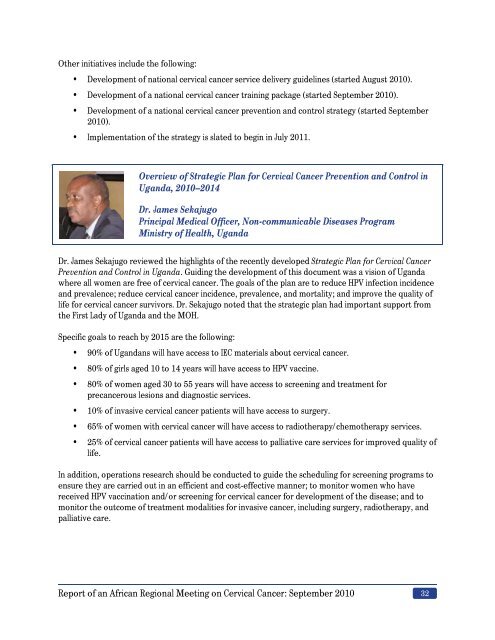Download file, English (1 MB PDF) - RHO
Download file, English (1 MB PDF) - RHO
Download file, English (1 MB PDF) - RHO
You also want an ePaper? Increase the reach of your titles
YUMPU automatically turns print PDFs into web optimized ePapers that Google loves.
Other initiatives include the following:<br />
• Development of national cervical cancer service delivery guidelines (started August 2010).<br />
• Development of a national cervical cancer training package (started September 2010).<br />
• Development of a national cervical cancer prevention and control strategy (started September<br />
2010).<br />
• Implementation of the strategy is slated to begin in July 2011.<br />
Overview of Strategic Plan for Cervical Cancer Prevention and Control in<br />
Uganda, 2010–2014<br />
Dr. James Sekajugo<br />
Principal Medical Officer, Non-communicable Diseases Program<br />
Ministry of Health, Uganda<br />
Dr. James Sekajugo reviewed the highlights of the recently developed Strategic Plan for Cervical Cancer<br />
Prevention and Control in Uganda. Guiding the development of this document was a vision of Uganda<br />
where all women are free of cervical cancer. The goals of the plan are to reduce HPV infection incidence<br />
and prevalence; reduce cervical cancer incidence, prevalence, and mortality; and improve the quality of<br />
life for cervical cancer survivors. Dr. Sekajugo noted that the strategic plan had important support from<br />
the First Lady of Uganda and the MOH.<br />
Specific goals to reach by 2015 are the following:<br />
• 90% of Ugandans will have access to IEC materials about cervical cancer.<br />
• 80% of girls aged 10 to 14 years will have access to HPV vaccine.<br />
• 80% of women aged 30 to 55 years will have access to screening and treatment for<br />
precancerous lesions and diagnostic services.<br />
• 10% of invasive cervical cancer patients will have access to surgery.<br />
• 65% of women with cervical cancer will have access to radiotherapy/chemotherapy services.<br />
• 25% of cervical cancer patients will have access to palliative care services for improved quality of<br />
life.<br />
In addition, operations research should be conducted to guide the scheduling for screening programs to<br />
ensure they are carried out in an efficient and cost-effective manner; to monitor women who have<br />
received HPV vaccination and/or screening for cervical cancer for development of the disease; and to<br />
monitor the outcome of treatment modalities for invasive cancer, including surgery, radiotherapy, and<br />
palliative care.<br />
Report of an African Regional Meeting on Cervical Cancer: September 2010 32
















